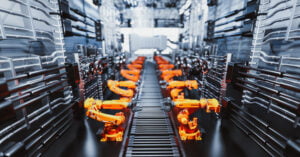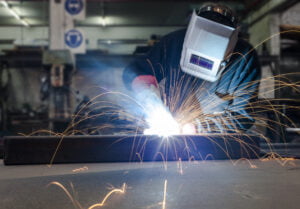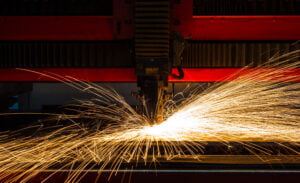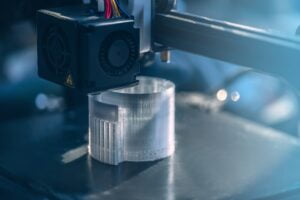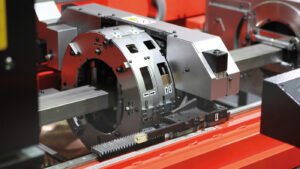Introduction
Laser cutters use a laser to vaporize material, resulting in a cut edge. The output of a high powered laser is directed, usually through optics, towards the material to be cut. Computer Numerical Control (CNC) is used to direct the laser or material. The laser beam, while in contact with the material, will melt, burn or vaporize the material.
History
The first production laser cutter was used to cut holes in diamond dies in 1965. This laser cutter was produced by the Western Electrical Engineering Research Centre. In 1965, The Welding Institute in Cambridge started to experiment with a laser-assisted by oxygen. These experiments would be used by some Boeing employees to evaluate whether it could be a viable method to cut Titanium and ceramics. They concluded that it could be a very efficient method, but they felt a good deal of research and development would be required before the technology could be applied to a production line. 1975 saw the first moving optics CO2 laser cutting system produced. This machine is still in use today, cutting holes in cowbells.
Science
The term laser stands for Light Amplification by Stimulated Emission of Radiation. A laser beam is created by electrons moving between power levels. Atoms are held in a special glass, crystal or gas. The electrons orbiting the atom nuclei become excited when they absorb energy, usually provided through electrical current or another laser. When these electrons absorb this energy, they will move to a higher energy orbit. These electrons will move back to their normal state, when they do, they will move back down to a lower power orbit. As they move down, they will emit photons, which are particles of light. As the energy levels are discrete, all electrons moving between the same two power levels will emit photons of the same wavelength and a coherent nature. Coherent light is of the same wavelength and has matching crests and troughs. As a laser beam is made up of coherent light, all photons will be of the same colour and the light will remain focussed over long distances.
Types of Laser Cutter
There are three main types of laser cutters. While each is very similar to the others, they differ in application.
CO2 lasers work by pumping a current through a gas mix, primarily consisting of carbon dioxide. These are the most common type of laser cutter as they are low power, relatively inexpensive and efficient. CO2 lasers can be used for a wide range of materials, going up to thin sheet metal.
Neodymium lasers form a beam making use of neodymium-doped crystals. With a small wavelength, the beam formed by neodymium based cutters has a higher intensity than CO2 lasers, allowing for the cutting of thicker and stronger materials. Neodymium lasers require a higher level of upkeep as the high-intensity beam can cause wear on parts of the laser cutter.
Fibre lasers use a seed laser, which is then amplified by glass fibre. Fibre lasers benefit from a very short wavelength, resulting in an extremely small spot size. Due to their design, fibre lasers offer benefits over other forms of laser. They are very efficient, meaning reduced energy consumption and running costs. The lack of optics saves on setup time and reduces maintenance. Also, as the spot size is so small, fibre lasers can process reflective materials.
Methods of Cutting
Several laser cutting methods exist, with different materials requiring different methods.
Vaporization cutting is a method used for material that doesn’t melt, such as wood and carbon. In this method, the beam is directed at the material, causing the material to heat up. Once the material heats to the flashpoint, the lowest temperature at which the vapours ignite, a keyhole is generated. This keyhole will cause a sudden increase in absorptivity, the rate of absorption of electromagnetic radiation (produced by the laser), which deepens the hole. As the hole deepens, the vapour generated will erode the molten walls and further enlarge the hole.
Melt and blow methods use a high-pressure gas to blow away the molten material. This results in a lower power requirement compared to vaporization as the material doesn’t need to be heated as much. This process is generally used on metals.
Brittle materials are generally prone to thermal fracture, where a material is heated unevenly causing stress to build within the material and an eventual fracture or crack. The laser beam is directed onto the material, causing localized heating. As the material heats, that area will expand while the rest of the material doesn’t. This forms a crack in the material, which can be guided by moving the laser. This is commonly used to cut glass.
Reactive cutting is generally only used for carbon steel and is similar to oxygen torch cutting. The laser will heat the material to its kindling temperature, which is the lowest temperature required to cause spontaneous ignition in a normal atmosphere. Oxygen is then blown over the material, causing a metal oxide to form. This metal oxide will form a layer above molten metal, as it is an impurity, so it is easily removed.


